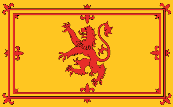HOME
SCOTLAND
Introdction to scotland
Tartans
Scotlands Government and Flags
Flower of Scotland
Toutrist Information
My Home Town
You Want to Know me
Email Me
Copyright © 1997
Dragon Lady
|

 The flag of
Scotland is the cross of St. Andrew, also known as the Saltire.
It is said to be the oldest national flag of any country, dating
back to at least the 12th century.
Tradition suggests that St. Andrew (an Apostle of
Jesus Christ in the Christian religion) was put to death by the
Romans in Greece by being pinned to a cross of this shape The
flag of the United Kingdom - known as the Union Jack or Union
Flag - is made up from the flags of Scotland, England (the Cross
of St. George), and Ireland (the Cross of St. Patrick). The flag of
Scotland is the cross of St. Andrew, also known as the Saltire.
It is said to be the oldest national flag of any country, dating
back to at least the 12th century.
Tradition suggests that St. Andrew (an Apostle of
Jesus Christ in the Christian religion) was put to death by the
Romans in Greece by being pinned to a cross of this shape The
flag of the United Kingdom - known as the Union Jack or Union
Flag - is made up from the flags of Scotland, England (the Cross
of St. George), and Ireland (the Cross of St. Patrick).
The Royal Flag
of Scotland
 There
is a second flag which is associated with Scotland, the
"Rampant Lion", or Royal Flag of Scotland. Although
based on an older Scottish Flag than the St. Andrews Cross, it
should, strictly speaking, now only be used by the monarch in
relation to her capacity as Queen of Scotland. Although Scotland
has not had its own monarchy since the Act of Union with England
in 1707, Queen Elizabeth II is monarch of United Kingdom of Great
Britain and Northern Ireland. This flag is widely used as a
second national flag. There
is a second flag which is associated with Scotland, the
"Rampant Lion", or Royal Flag of Scotland. Although
based on an older Scottish Flag than the St. Andrews Cross, it
should, strictly speaking, now only be used by the monarch in
relation to her capacity as Queen of Scotland. Although Scotland
has not had its own monarchy since the Act of Union with England
in 1707, Queen Elizabeth II is monarch of United Kingdom of Great
Britain and Northern Ireland. This flag is widely used as a
second national flag.
The Rampant Lion flies over the offices of the Secretary of State
for Scotland (who is the represenative of the U.K. government in
Scotland); that is the Dover House in London and the New St.
Andrews House in Edinburgh.
King George V signed a Royal Warrant in 1934 allowing the use of
the Rampant Lion flag as "a mark of loyalty" because of
the forthcoming Jubilee celebrations. The Lord Lyon (The Lord
Lyon of Arms is the judicial officer responsible for upholding
the heraldic law in Scotland) officially now takes the view that
this permission "related to decorative ebullition",
that is, it is permissable to wave the flag at football matches.
It is however not allowable to fly the flag without permission,
on a flag pole or from a building. The Lord Lyon once threatened
the town councillors of Cumbernauld with an Act passed in 1679
which prescribed the death penalty for mis-use of the royal arms.
|